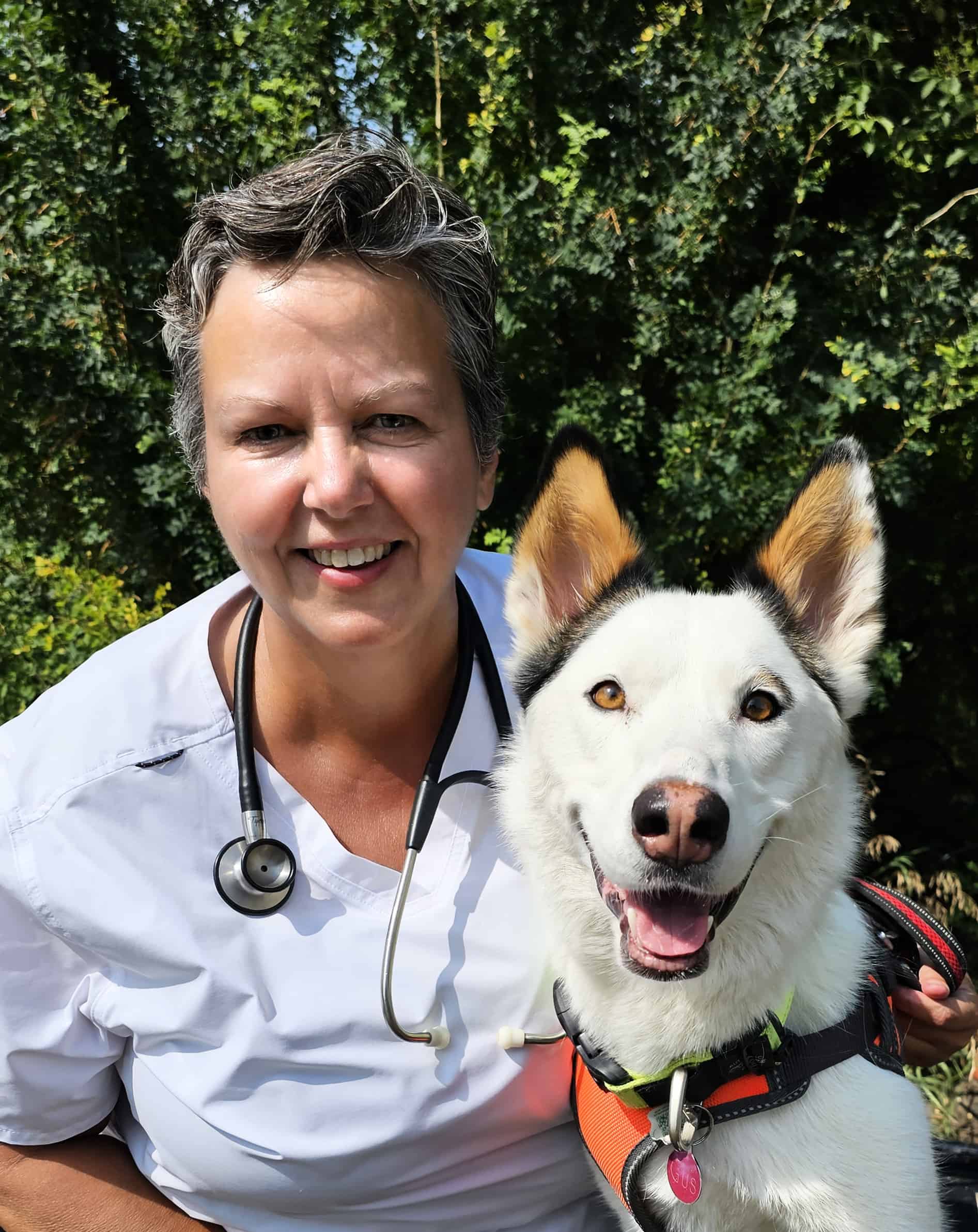You may have heard about Bengal cats and are wondering what all the fuss is about them. You may also be wondering if they make good pets.
Bengal cats are quickly becoming one of the most sought-after breeds in the world. With their exotic looks, intelligence, and loving personalities, it’s no wonder why they have become so popular.
If you’re looking for an intelligent, active pet with a unique personality then a Bengal may be for you. Read on to learn more about Bengal Cats, including breed information and care tips.
Table of Contents
ToggleBengal Cat Breed Origins
The Bengal cat has its origins in two main breeds. These are the Asian Leopard Cat and the domestic shorthair cat. The original Bengal was bred to create an exotic-looking housecat with wild features, but also with a friendly and gentle temperament.
The Egyptian Mau and Abyssinian breeds were popular selections for the initial F1 cross. These crosses resulted hybrids with a very distinct spotted coat pattern. The F1 cross was then mated to another domesticated breed which started to bring the wild characteristics in line with the temperament of a housecat.
Bengal cats are a relatively new breed on the scene. The first mention of this hybrid cross is from the late 1800s, but the establishment of this breed didn’t come until much later.
It was around the 1970s that the breeding of these unique cats took off. Although the breed has its roots in Asian and Egyptian cat breeds, the Bengel breed itself is rooted in breeding efforts that took place in the United States.
The Bengal cat breed was accepted by The International Cat Association in 1983, and over the next couple of decades, it was added to the registries of several more organizations. The last organization to recognize it as a breed was the Cat Fancier’s Association in 2016.
Today, the Bengal cat breed is stable, and the breed is continued through the mating of existing Bengals.
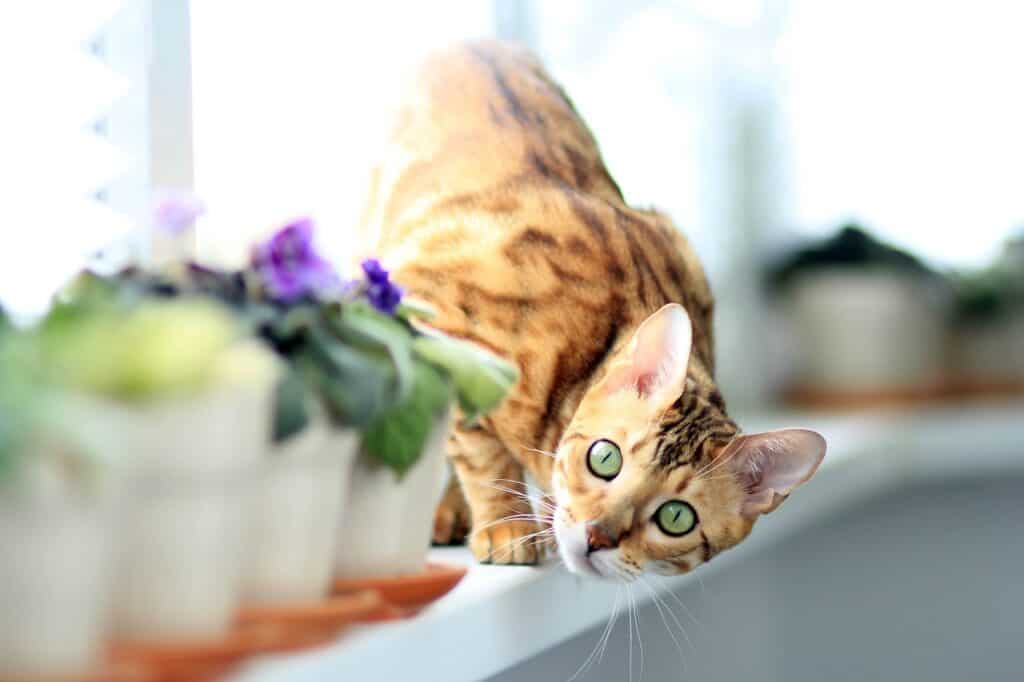
Bengal Cat Characteristics
Bengal cats are known for their distinct physical features, distinctive coats, unique personalities, and for their vocalizations. But they also have many other interesting characteristics that make them unique pets.
Bengal Cat Intelligence
One of the most popular traits of Bengal cats is their intelligence. They are very eager to learn new things and can learn to do various tricks, tasks, and activities. Bengals also have a natural curiosity – they love exploring and playing with toys.
Are Bengal Cats Affectionate?
Bengal cats are generally friendly and affectionate animals. It can be hard to tell this sometimes, as they are not particularly fond of being held or sitting on laps.
They do show affection in their own ways, such as following their owners around the house, head-butting them when they are feeling particularly loving, and making chirping noises.
Are Bengal Cats Friendly With Other Animals?
Bengal cats are known for being territorial, and therefore might not be friendly to new animals. They do, however, bond with other animals they are raised with and can often become very attached to their housemates.
Are Bengal Cats Good With Children
Kids and Bengal cats share the same traits – they love to play, and they love to talk! Bengals are generally very good with children and are usually quite gentle with them. They instinctively know not to use their claws and teeth while playing with little ones.
That said, like any other cat breed they do best when raised with children. An adult Bengal cat that has never been around children before might not be comfortable around them. In this case, interactions between the cat and the child should be supervised closely.
Bengal Cat Personality
Bengal cats are typically very active, playful, and curious. They are known for their intelligence and can learn to do various tricks, tasks, or activities. Some people describe them as more dog-like than cat-like in this manner.
These cats have bold personalities. They have strong hunting instincts and love climbing, jumping, and running around the home. They are very vocal and often chatty with their owners.
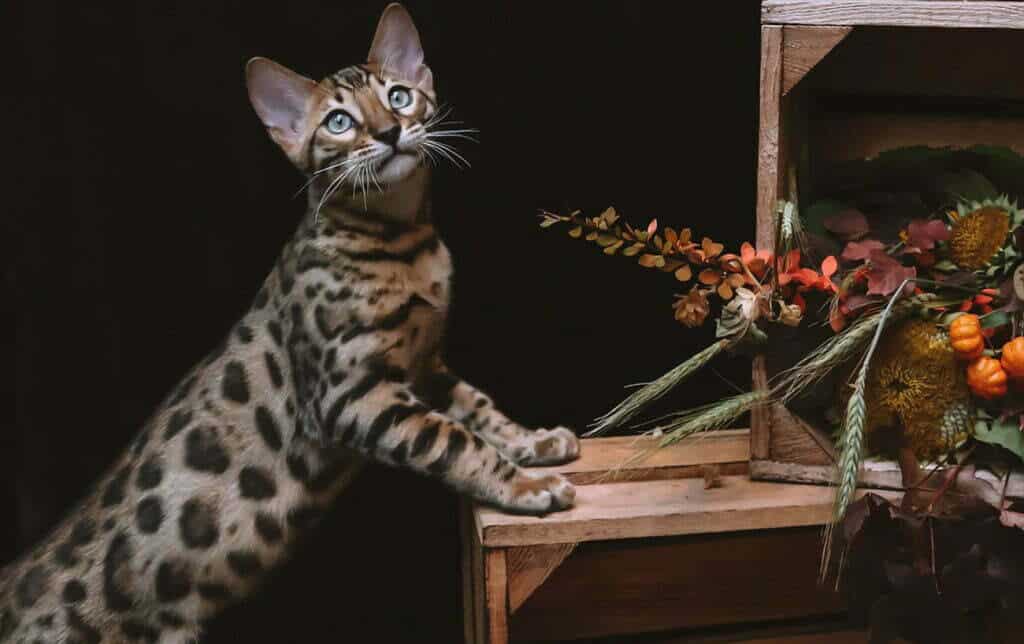
Bengal Cat Vocalization
One thing is certain – Bengal cats love to talk! They have an extensive range of noises that they use to communicate with their owners and other animals. Their ranges of vocalizations included chirps, chortles, meows, trills, meows, and purrs.
Bengals may also make a variety of “barking” sounds – I found this out for myself with my Bengal kitten who absolutely hated being in the cat carrier. She let her feelings be known with a whole range of feline “barks” and yowls which were very loud and very wild sounding.
Bengal Cat Energy Level and Exercise Needs
Bengal cats are very active and athletic. They have high energy levels and need vigorous episodes of running, jumping, and climbing to burn it all off.
These cats need access to scratching posts and plenty of toys to keep them entertained, otherwise, they may become destructive, using their energy to claw up your furniture and other possessions.
Bengal cats are also excellent climbers. Cat trees or wall shelves can provide them with the opportunity to climb safely. Cat trees should be tall, with plenty of features for them to climb, explore and play on, such as this highly-rated cat tree house by Go Pet Club.
Your Bengal cat will love playing with you, especially if your playing involves chasing and other exercise. You may also consider training your cat to walk on a leash and harness so that you can both exercise outside together.
Are Bengal Cats Easy to Train
Although they can be stubborn at times (what cat isn’t!) Bengal cats are known to be highly intelligent and inquisitive. These traits make them relatively easy to train. Bengals have been known to learn commands in as little as a few weeks.
If you are looking for a cat that can be trained to do tricks and basic commands, then the Bengal may be the ideal choice for you.
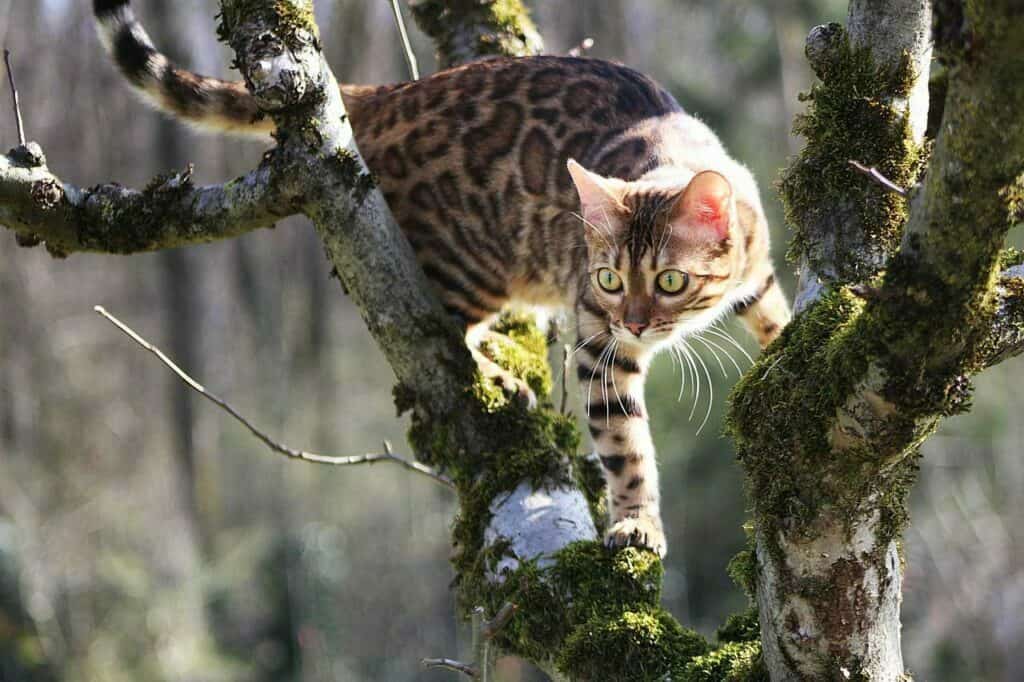
Bengal Cat Appearance
How Big Do Bengal Cats Get?
Bengal cats are medium to large-sized cats. Their size varies depending on the breed of cat used in the original hybrid cross. Bengal cats range in size from seven to fifteen pounds, with the males being larger than the females.
Bengal Cat Body Type
True to their wildcat origins, Bengal cats tend to have a lean, muscular, and athletic body type. Their bodies are longer than they are tall, with back legs that are slightly longer than their front legs. Bengals also have large round eyes and ears that are a bit larger than many other cats, which adds to their wildcat appearance.
Bengal Cat Fur Type
Most Bengal cats are shorthair. Their fur is often described as super-soft, more like rabbit fur than cat fur.
There are a few longhair lines of Bengals, which originated either from a longhaired ancestor in the original crosses or through the presence of recessive genes. Longhair Bengals are not yet widely accepted in Bengal breed registries.
Bengal Cat Coat Colors
Bengals are beautiful cats with a wide array of coat colors, though not all colors, such as melanistic (black on black) are recognized by breed standards.
Colors that have been acknowledged by the International Cat Association include Brown Spotted Bengals, Seal Lynx Point (snow) Bengals, Sepia Bengal cats, Silver-colored Bengals, and Mink Spotted Tabby Bengal cats.
Bengal Cat Coat Patterns
One of the most distinctive features of the Bengal cat is its coat patterns. The Bengal cat coat pattern is the result of hybridization between domestic cats and Asian Leopard Cats. This unique coloration gives each individual Bengal an exotic and beautiful appearance.
Bengal coats can come in several different patterns, including spotted, rosetted, marbled, and charcoal tabby patterns. The different patterns combined with different colors means that Bengal cats vary widely in appearance, and no two cats are exactly alike!
Bengal Cat Eye Color
The eye color of a Bengal is heavily influenced by its non-Bengal domestic cat origins. As different breeds have been used to produce the different Bengal cat colors and patterns, their eyes differ accordingly.
Eye color is strongly associated with coat color. An array of radiant colors including blue, green, gold, yellow, hazel, and orange/gold are all part of this remarkable feline’s distinctively captivating beauty.
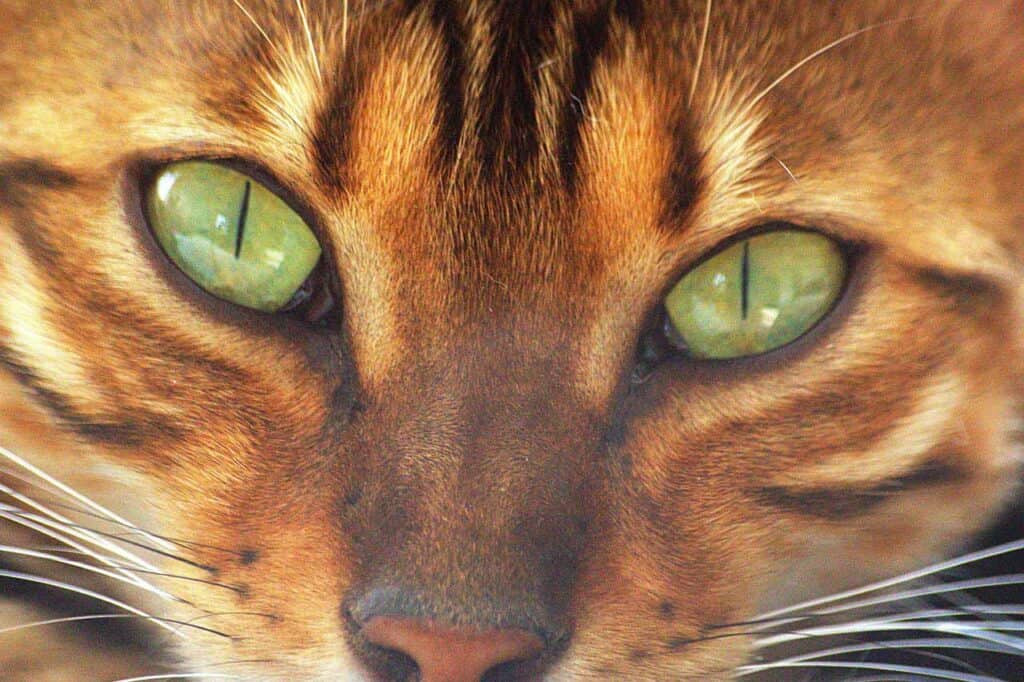
Bengal Cat Lifespan
Bengal cats have the same average lifespan as other indoor domestic cats. Healthy individuals can live to 15 years or more, although the average lifespan is a little less than this due to breed-related health issues.
Bengal Cat Health Issues
Bengal cats are known to be generally healthy, however, they can suffer from the same health conditions as any other cat. They are also predisposed to several genetic diseases that can be identified through genetic testing or regular health screening.
Three of the most common genetic health issues in Bengals include:
Progressive retinal atrophy (PRA): PRA is a genetic disorder that can cause blindness in cats. Retinal damage starts when the cat is just a kitten, and by two years old their vision is severely impaired. Breeding cats should be tested for this disease, and genetic carriers should not be used for breeding.
PK deficiency: This is a genetic disorder that leads to anemia with various signs of illness. These include intense fatigue, instability, weight loss, yellowing of the skin and eyes (jaundice), as well as enlargement of the abdomen. The age at which these symptoms begin to appear varies from case to case. Genetic screening for carriers is a must for breeders.
Feline hypertrophic cardiomyopathy (HCM): HCM is an inherited heart disease that affects Bengals and other breeds of cats. This disease results in the thickening of the walls of a cat’s heart, which reduces heart efficiency. There is no genetic test for this. Breeding animals should be examined regularly by a vet, and any animal that develops HCM must not be used for breeding.

Bengal Cat Care
Grooming
Like other cats, Bengals need regular brushing to keep their coats shiny and healthy – once or twice a week will do the trick. Brushing will help to remove any debris or dead hair from their coats. It can also help reduce shedding.
Bengal cats have a love for the water and most enjoy having a bath. Limit baths to no more than once or twice a month to prevent drying out their skin and coat. When bathing, use a gentle shampoo made specifically for cats.
Bengal cats should also have their nails trimmed regularly to keep them from becoming too long and sharp. If you are not sure how to trim your cat’s nails, ask your veterinarian or groomer to show you how.
Check your cat’s ears weekly for any signs of wax buildup or infection. Clean them with a damp cloth or cotton ball moistened with a solution recommended by your veterinarian.
It is also recommended that Bengal cats have their teeth brushed regularly. Cats are not particularly fond of teeth brushing as most cat owners can tell you! But if you can teach your cat to tolerate having its teeth brushed, it will help prevent a lot of dental disease in the long run.
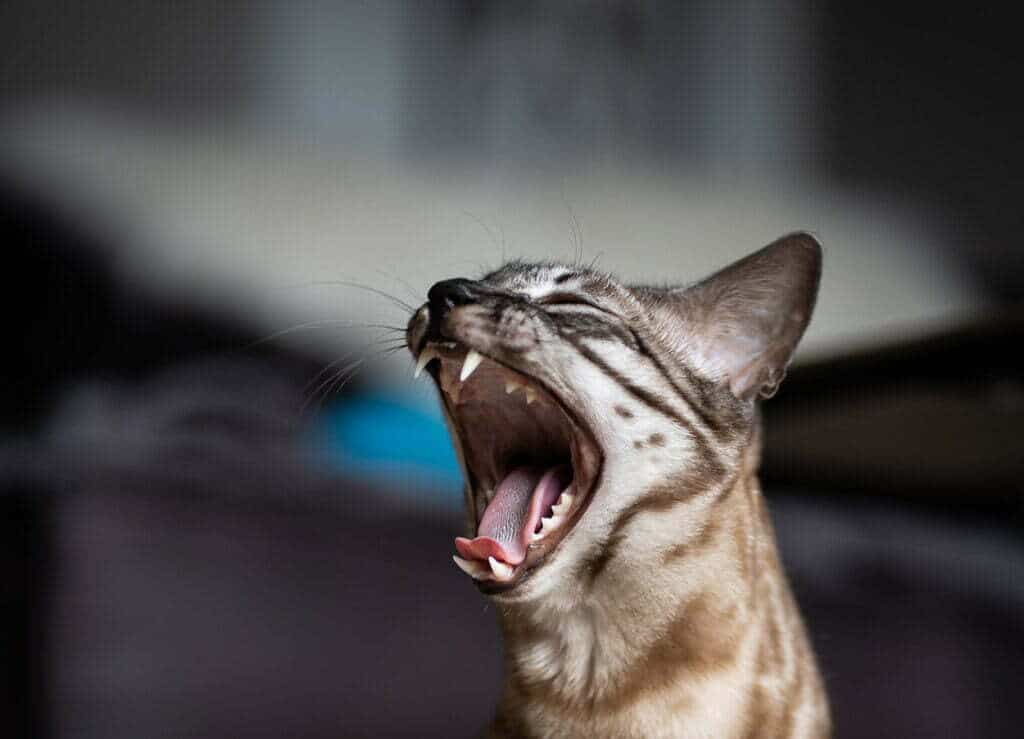
Diet and Nutrition
Bengal cats do not need a specialized diet. They eat the same foods that other house cats do. Some owners may choose to feed a raw diet, while others will choose a commercial cat food that is more convenient.
Whichever food you feed your Bengal cat, the important thing is that it is a well-balanced diet made of quality ingredients. Raw food diets can be tricky to balance yourself, due to the specific nutritional needs of cats.
If you do feed a raw food diet, do so in consultation with a pet nutritionist or your veterinarian to be sure your cat’s nutritional needs are being met.
Are Bengal Cats Hypoallergenic?
There is no scientific evidence that Bengal cats are hypoallergenic. While some people may have less of a reaction to Bengal cats than other breeds, there is no guarantee that this will be true for everyone.
The American Asthma and Allergy Foundation does not recognize any cat as being hypoallergenic.
Where To Buy Bengal Cats
Although I advocate for adopting from shelters whenever possible, you are unlikely to find a Bengal cat in your local animal shelter. If you have set your heart on a purebred Bengal, then your best bet is to find a reputable breeder.
When looking for a Bengal cat breeder, it’s important to do your research and ensure that they adhere to ethical standards. The breeder should be able to show you documents demonstrating that the cat has been tested for common genetic diseases and any other health issues.
You can try a Bengal-specific rescue group as well to see if they have adoptions available in your area.
Bengal Cat Price
The price of a Bengal cat can vary considerably, depending on whether the cat is show quality, pet stock, and reputation of the breeder, among others. The average cost of a Bengal kitten is between $1500 – $3000 USD.
You can expect to pay quite a bit for show-quality individuals from popular breeders, starting at around $3000 USD and going up from there. If you are lucky, you may find non-registered pet stock available for $500-$700 USD.
Conclusion – The Nitty-Gritty About This Kitty
Overall, Bengal cats are a great choice for pet owners who want an exotic-looking and intelligent feline. They are energetic and playful, and their intelligence makes them interesting companions.
However, if you are looking for a lap kitty, then a Bengal is likely not for you, as they can also be independent and stubborn. Quiet and calm they are not!
One thing is for certain though – your life will definitely be more interesting with a Bengal cat in it.
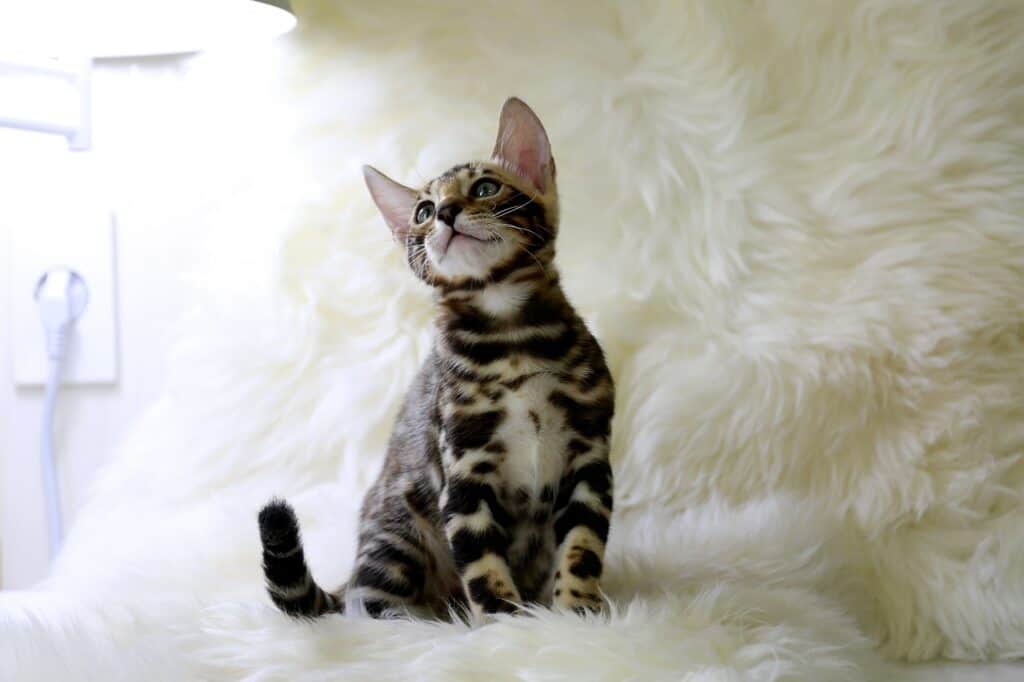
Author
-
Dr. Wendy Wilkins is an experienced veterinarian and epidemiologist with over 20 years of expertise. She holds a Doctor of Veterinary Medicine (DVM) degree and a Doctorate in Epidemiology from the University of Saskatchewan. Throughout her career, Dr. Wilkins has excelled in clinical practice, academia, research, and regulatory veterinary medicine. She is a respected voice in knowledge dissemination, delivering factual information in a readable and understandable manner through articles, books, and public engagements.


